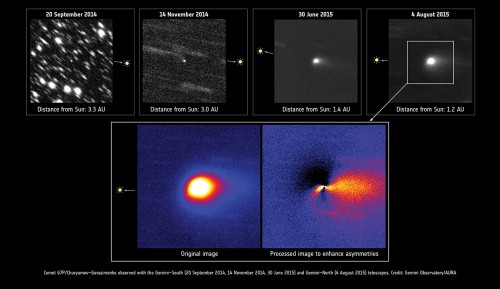- Date: 13 Aug 2015
- Comments: (0)
- Categories: For Astronomers, Science Results

Comet 67P/Churyumov-Gerasimenko observed with the Geini-South (20 September 2014, 14 November 2014, 30 June 2015) and Gemini-North (4 August 2015) telescopes. Credit: Gemini Observatory/AURA
In March 2004, Europe’s comet chaser Rosetta launched when an Ariane 5 rocket lifted off from Kourou in French Guiana. Its destination: a periodic comet known as Comet 67P/Churyumov–Gerasimenko.
More than 10 years passed before the mission experts can celebrate perihelion – the closest point to the Sun along the comet’s orbit. This event was held live in a Google hangout August 13th.
Gemini Observatory played an important role capturing images with Flamingos- 2 and NIRI’s instruments from Gemini North and South in the evolution of Rosetta target as it approached the Sun.
“We are really pleased at Gemini to be able to continue contributing to the Rosetta mission. These are very challenging observations, taken low in the sky and close to Sunrise, and it is very rewarding to see such sharp images of the comet. Linking the large scale with the small, these observations will provide key insights into our understanding of cometary activity. As Comet 67P begins its journey away from the Sun, Gemini will be there monitoring its progress. We look forward to obtaining even more exciting pictures of this comet in the coming year”. Added Blair Conn, Gemini South Assistant Scientist.
If you want more information, follow this link





